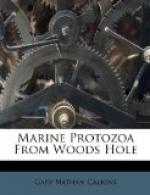Fresh and salt water.
Euplotes charon Ehr. Fig. 52.
Synonyms: Trichoda charon Mueller; Ploesconia charon; P. affinis, subrotunda, radiosa, longiremis, Dujardin ’41.
The body is oval, small, and somewhat variable in length. The carapace is strongly marked upon the dorsal side by deep longitudinal grooves, 6 to 8 in number; the grooves may be absent, however. The adoral zone extends to the posterior third of the body, the mouth and oesophagus are directed anteriorly. There are 10 ventral cirri, 7 of which are on or near the frontal border and 3 near the right edge. There are 5 posterior cirri and 4 anal cirri, of much smaller size. The cirri may or may not be fimbriated, the latter condition indicating the approaching disintegration of the body and is abnormal. The macronucleus is long and band-formed or horseshoe shape. The contractile vacuole lies on the right side dorsal to the posterior cirri.
Fresh and salt water. Length 45 mu; diameter 25 mu.
[Illustration: Fig. 52.—Euplotes charon, dorsal and ventral aspects.]
Euplotes harpa Stein. Fig. 53.
The body is elongate, oval, somewhat widened anteriorly, and has rounded ends. The frontal margin is three-toothed. Ten ventral cirri. Dorsal surface provided with 8 longitudinal markings. The peristome is long and broad, with considerable variation. The adoral zone consists of powerful membranelles arranged in a continuous curve from the mouth to the extreme right frontal margin. Seven of the 10 ventral cirri are situated at the anterior extremity; the remainder are arranged in a triangle on the right edge. The anal cirri, 5 in number, are long and stiff; the marginal cirri smaller and finer. The nucleus and contractile vacuole are similar to those of the preceding species.
Length 95 mu; width 54 mu.
[Illustration: Fig. 53.—Euplotes harpa.]
Genus DIOPHRYS Dujardin ’41.
(Buetschli ’88.)
Medium size, colorless to yellow, rigid in form. The body contour is oval, the anterior end being rounded or slightly reduced, the posterior end usually cut in on the right side. The peristome is broad but less extensive than in Euplotes, and may extend beyond the middle of the body. Its right edge is convex toward the right side, extends forward and does not turn again to the right. The anterior ventral surface has 7 to 8 scattered cirri and just behind the mouth is a transverse row of large anal cirri. In the sharp in-cut of the posterior end are three great angular cirri. Two lateral cirri are placed on the left of the median line between the mouth and the anal cirri, and usually in a slight hollow. The contractile vacuole is on the right side in the vicinity of the anal cirri. The macronucleus is in two parts, each band-form, one anterior, the other posterior in position. Movement is rapid and steady. Salt water.




